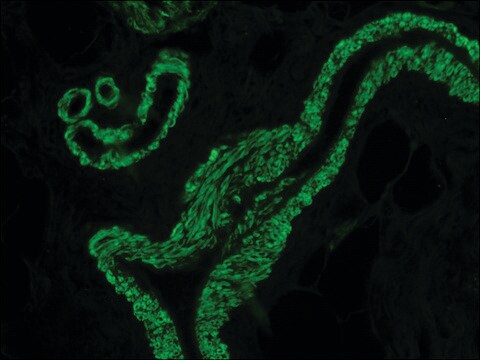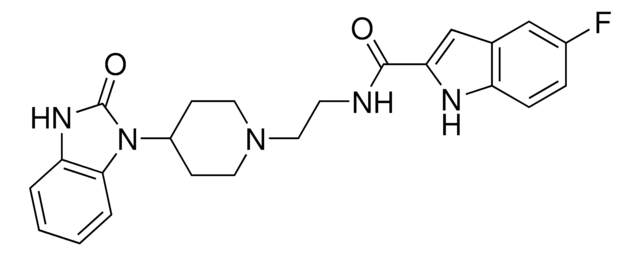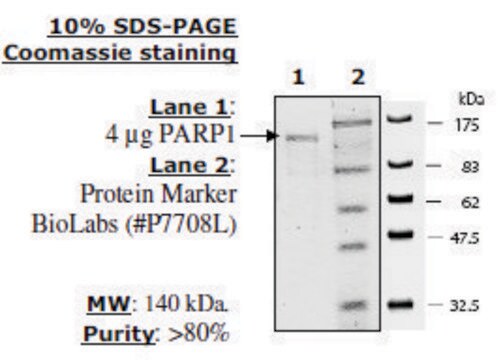F5807
FIPI hydrochloride hydrate
≥98% (HPLC), powder
동의어(들):
4-Fluoro-N-(2-(4-(5-fluoro-1H-indol-1-yl)piperidin-1-yl)ethyl)benzamide, 5-Fluoro-2-indolyl des-chlorohalopemide hydrochloride hydrate
로그인조직 및 계약 가격 보기
모든 사진(1)
About This Item
실험식(Hill 표기법):
C23H24FN5O2·HCl · xH2O
CAS Number:
Molecular Weight:
457.93 (anhydrous basis)
MDL number:
UNSPSC 코드:
12352204
PubChem Substance ID:
NACRES:
NA.77
추천 제품
Quality Level
분석
≥98% (HPLC)
양식
powder
저장 조건
desiccated
색상
off-white
solubility
DMSO: >20 mg/mL
저장 온도
2-8°C
SMILES string
O.Cl.Fc1ccc2[nH]c(cc2c1)C(=O)NCCN3CCC(CC3)N4C(=O)Nc5ccccc45
InChI
1S/C23H24FN5O2.ClH.H2O/c24-16-5-6-18-15(13-16)14-20(26-18)22(30)25-9-12-28-10-7-17(8-11-28)29-21-4-2-1-3-19(21)27-23(29)31;;/h1-6,13-14,17,26H,7-12H2,(H,25,30)(H,27,31);1H;1H2
InChI key
ZORDQKCXPCXYKL-UHFFFAOYSA-N
애플리케이션
FIPI (4-Fluoro-N-(2-(4-(5-fluoro-1H-indol-1-yl)piperidin-1-yl)ethyl)benzamide, 5-Fluoro-2-indolyl des-chlorohalopemide) is used to study the cell signaling pathways, cell processes and cell dysregulations that depend upon phospholipase D1 (PLD1) and phospholipase D2 (PLD2) activities. FIPI may be used to help identify and characterized phospholipase D enzymes.
생화학적/생리학적 작용
FIPI is a potent Phospholipase D (PLD) inhibitor. The signaling enzyme Phospholipase D (PLD) and the lipid second messenger phosphatidic acid (PA) generated by PLD are implicated in many cell biological processes including Ras activation, cell spreading, stress fiber formation, chemotaxis, and membrane vesicle trafficking. FIPI is a potent in vivo inhibitor of both PLD1 and PLD2, setting the stage for a new era of exploration and validation of cell biological roles for mammalian PLD. It rapidly blocks in vivo PA production with sub-nM potency. FIPI inhibits PLD regulation of F-actin cytoskeleton reorganization, cell spreading, and chemotaxis, indicating potential utility for it as a therapeutic for autoimmunity and cancer metastasis. It does not affect PLD subcellular localization, PIP2 availability, the actin stress fiber network in resting CHO cells, or selected signaling events proximal to PLD activation.
FIPI is a potent phospholipase D (PLD) inhibitor effective at sub-nM levels. Phospholipase D (PLD) and the lipid second messenger phosphatidic acid (PA) generated by PLD are implicated in many cell biological processes including Ras activation, cell spreading, stress fiber formation, chemotaxis, and membrane vesicle trafficking. FIPI inhibits both PLD1 and PLD2, rapidly blocking in vivo PA production. FIPI inhibits PLD regulation of F-actin cytoskeleton reorganization, cell spreading, and chemotaxis, suggesting potential as a therapeutic for autoimmune diseases and cancer metastasis.
신호어
Warning
유해 및 위험 성명서
Hazard Classifications
Eye Irrit. 2 - Skin Irrit. 2 - STOT SE 3
표적 기관
Respiratory system
Storage Class Code
11 - Combustible Solids
WGK
WGK 3
Flash Point (°F)
Not applicable
Flash Point (°C)
Not applicable
My career as a cardiologist and the developmental history of coronary intervention in Japan.
Masakiyo Nobuyoshi
Cardiovascular intervention and therapeutics, 25(2), 51-52 (2010-07-01)
David Stegner et al.
Arteriosclerosis, thrombosis, and vascular biology, 33(9), 2212-2217 (2013-07-23)
We recently showed that mice lacking the lipid signaling enzyme phospholipase (PL) D1 or both PLD isoforms (PLD1 and PLD2) were protected from pathological thrombus formation and ischemic stroke, whereas hemostasis was not impaired in these animals. We sought to
Han Han et al.
Molecular cell, 72(2), 328-340 (2018-10-09)
The Hippo pathway plays a crucial role in organ size control and tumor suppression, but its precise regulation is not fully understood. In this study, we discovered that phosphatidic acid (PA)-related lipid signaling is a key regulator of the Hippo
Xiao Tang et al.
Journal of immunology (Baltimore, Md. : 1950), 195(3), 1191-1201 (2015-06-28)
Bioactive peptide LL-37/hCAP18, the only human member of the cathelicidin family, plays important roles in killing various pathogens, as well as in immune modulation. We demonstrate that LL-37 is internalized by human macrophages in a time-, dose-, temperature-, and peptide
자사의 과학자팀은 생명 과학, 재료 과학, 화학 합성, 크로마토그래피, 분석 및 기타 많은 영역을 포함한 모든 과학 분야에 경험이 있습니다..
고객지원팀으로 연락바랍니다.






